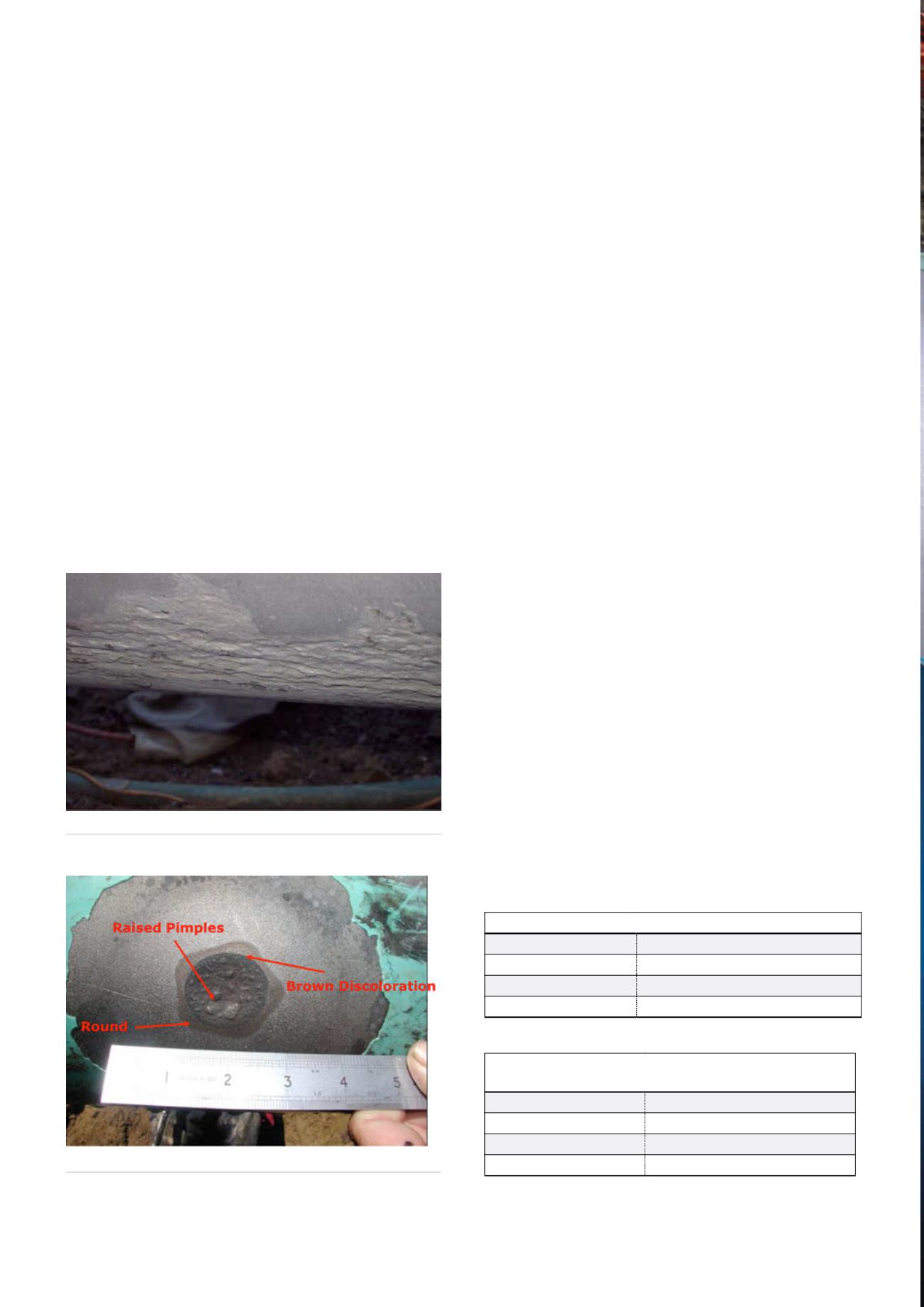
Figures 1 - 7 show corrosion attributable to several of these
corrosion mechanisms, with their characteristic morphologies.
These factors are typically localised rather than systemic. Where
the root cause analysis identifies additional factors as contributors
to metal loss, appropriate solutions should be developed by
qualified individuals. In general, the application of cathodic
protection (CP) is the most effective corrosion control method
to address metallic surfaces that are not isolated from the soil
environment by protective coatings (i.e., at coating flaws). CP
alone may not be the most practical approach to all factors or
combinations of factors. For example, stray current influences,
whether static or dynamic, are often best controlled at the source
rather than attempting to overpower them with CP.
The recognised standard of the corrosion control industry is
that effective control, and specifically effective CP, is achieved
when the corrosion rate is reduced to less than 0.025 mm/yr
(1 mil/yr).
Some of the factors listed above may require increased
protective current densities to achieve the recognised CP criteria.
Others may require modifications to the criteria – for example,
the International Standards Organisation (ISO) has established a
polarised potential criterion of -950 mV (additional 100 mV of
polarisation) in the presence of active MIC to achieve a reduction
in the corrosion rate to less than 1 mil/yr.
Electrical shielding encompasses conditions that do not
actually affect the corrosion rates of the general soil environment;
rather, they create a separate environment for portions of the
pipe surface and prevent the distribution of cathodic protection
current into those areas. The most common conditions that cause
electrical shielding include disbonded coating, other dielectric
barriers around the pipe, non-conductive rock formations or
geological features, and intervening metallic structures such as
parallel pipelines or shorted casings.
Effect of CP
The following citations are not intended to summarise or critique
the related CP criteria. Rather, they are intended to demonstrate
that the definition of ‘effective cathodic protection’ as a reduction
of the corrosion rate to less than 1 mil/yr is fundamental to
the historical research and generally accepted throughout the
corrosion control industry.
In the Cathodic Protection 2 Education Course, NACE
International has recognised the generally accepted industry
definition of effective corrosion control: under the ‘Basis of
RP0169 Criteria’ section (now SP0169), regarding the -850 mVCSE
polarisation criterion, the text states “it is generally agreed that
this criterion reduces corrosion to approximately 1 mil/yr.”
NACE International’s Standard Practice, SP0169-2013, ‘Control
of External Corrosion on Underground or Submerged Metallic
Piping Systems’ states, “a commonly used benchmark for effective
external corrosion control is a reduction in the corrosion rate to
0.025 mm/yr (1 mil/yr) or less.”
850 mV negative polarised pipe-to-soil
potential
In order to provide a consistent basis for comparison of
experimental results, the classic research adopted the common
definition of effective CP as the reduction of corrosion rates to
less than 1 mil/yr (0.025 mm/yr). Some of the more significant
examples follow:
)
)
Schwerdtfeger & McDorman, 1952
1
: “the corrosion rate had
reached a negligible value…this value is associated with
corrosion rates that are less than 1 mil/yr.”
)
)
Thompson and Barlo
2
: “corrosion is assumed to be mitigated
when the corrosion rate falls below 1 mil/yr.”
Table 1. Table SP-B1 (adapted from ASME B31.8S)
6
Corrosion rate (mil/yr)
Soil resistivity (OHM-CM)
3
>15 000 + no active corrosion
6
1000 - 15 000 and/or active corrosion
12
<1000 (worst case)
Table 2. Table 11.6 rough current requirements for CP of steel
(excerpted from Peabody, p. 499)
7
Conditions for bare steel
Current required (mA/m
2
)
In moving seawater
100 - 160
In quiet seawater
55 - 85
In earth
10 - 30
Figure 1.
General corrosion.
Figure 2.
A-C corrosion.
114
World Pipelines
/
AUGUST 2015


